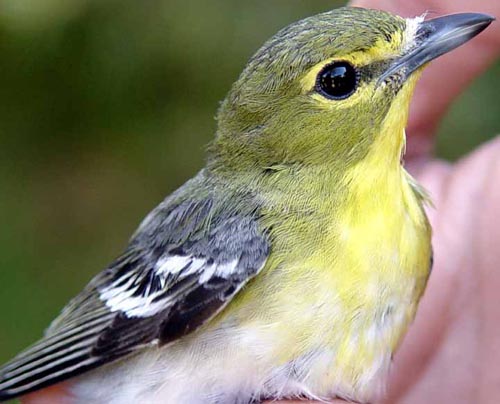 Yellow-throated
Vireo is a rare vagrant in Monterey County; records are split rather evenly
between spring and fall vagrants along the coast, but two individuals summered
(or attempted to do so). Four of the 8 records through spring 2004 were
at the Big Sur R. mouth, including three singing males between mid-May
and mid-June. This photo (left) is of one of those birds, captured
and banded by BSOL on 20 May 2004 [photo © Ventana Wilderness
Society]. It provided the 8th MTY record. Yellow-throated
Vireo is a rare vagrant in Monterey County; records are split rather evenly
between spring and fall vagrants along the coast, but two individuals summered
(or attempted to do so). Four of the 8 records through spring 2004 were
at the Big Sur R. mouth, including three singing males between mid-May
and mid-June. This photo (left) is of one of those birds, captured
and banded by BSOL on 20 May 2004 [photo © Ventana Wilderness
Society]. It provided the 8th MTY record.
This photo of a spring male shows many of the classic features of Yellow-throated Vireo:
Yellow-throated Vireo is a nesting species of the eastern United States, barely reaching southeastern Canada, that winters from south Florida and southeast Mexico to northern South America. It is a vagrant anywhere west of the Rocky Mountains but there are about 60 California records, of which two-thirds have been in the spring. Two have wintered in southern California. |
|
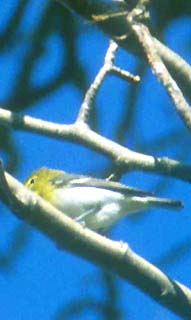  This
May 2004 vireo remained along the Big Sur River, singing from the tall
cottonwoods and sycamores, through at least 24 May; it was photographed
in the field on 23 May for what may be the only "field" photos of this
species in the county (right; © Don Roberson). On 24 May it had joined
mixed chickadee-warbler flocks by mid-day, and then was seen to drink from
the edge of the Big Sur River and also bathe in the river right next to
the BSOL bridge. [BSOL bands birds on the right leg, so you can't see the
band in these shots.] This
May 2004 vireo remained along the Big Sur River, singing from the tall
cottonwoods and sycamores, through at least 24 May; it was photographed
in the field on 23 May for what may be the only "field" photos of this
species in the county (right; © Don Roberson). On 24 May it had joined
mixed chickadee-warbler flocks by mid-day, and then was seen to drink from
the edge of the Big Sur River and also bathe in the river right next to
the BSOL bridge. [BSOL bands birds on the right leg, so you can't see the
band in these shots.] |
|
|
|
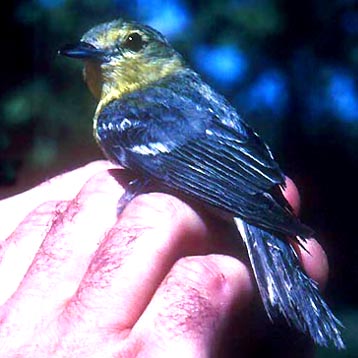 It
was 18 years after the dead Carmel Valley bird before MTY recorded its
second Yellow-throated Vireo (right; in-hand photo at BSOL ©
Don Roberson). Big Sur Ornithology Lab (BSOL) captured this adult about
9 a.m. on 28 July, and held the bird long enough for several to arrive
to view it in hand (e.g., Jim Booker, Rita Carratello, Bob Maurer, Don
Roberson, Steve Rovell, Bill Rydell). Booker was able to age it as a first-summer
bird ("SY" in banding lingo). A number of observers followed it after its
release as it joined a flock of chickadees and bushtits along the Big Sur
River, occasionally giving a very loud, harsh, husky scold. It
was 18 years after the dead Carmel Valley bird before MTY recorded its
second Yellow-throated Vireo (right; in-hand photo at BSOL ©
Don Roberson). Big Sur Ornithology Lab (BSOL) captured this adult about
9 a.m. on 28 July, and held the bird long enough for several to arrive
to view it in hand (e.g., Jim Booker, Rita Carratello, Bob Maurer, Don
Roberson, Steve Rovell, Bill Rydell). Booker was able to age it as a first-summer
bird ("SY" in banding lingo). A number of observers followed it after its
release as it joined a flock of chickadees and bushtits along the Big Sur
River, occasionally giving a very loud, harsh, husky scold.
This vireo remained along the Big Sur River near BSOL (about a mile from the mouth) for the next six weeks, and went through a complete molt. It was recaptured twice and on its final recapture on 17 Sep was in crisp, fresh plumage. Note just how ratty and worn the bird looks in the July photo, with its tail particularly bedraggled. Fall birds are very bright and crisp; see the description following the list of records for an example [no fall bird has yet been photographed in MTY]. Pyle's (1997) Identification Guide to North American Birds describes this species as having one complete molt each year — on the summering grounds (Jul-Sep) — and a partial molt on the wintering grounds (Jan-Apr). Hatch-year birds have a partial molt soon after fledging but retain the juvenal wings and tail to the next summer. |
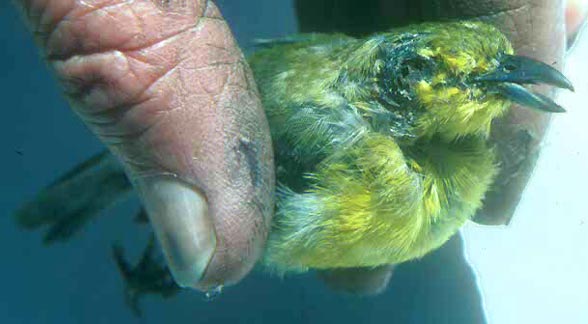
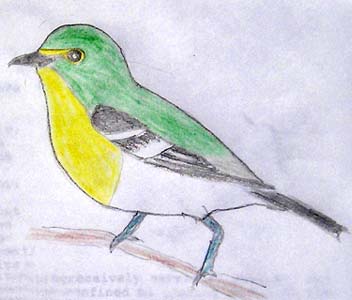 YELLOW-THROATED
VIREO Vireo flavifrons
YELLOW-THROATED
VIREO Vireo flavifrons